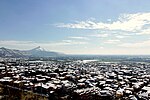Tecnam
Costruzioni Aeronautiche TECNAM S.p.A., commonly known as simply Tecnam, is an Italian aircraft manufacturer. The company has two primary activities: producing aircraft components for various other manufacturers, and manufacturing its own range of light aircraft. The company was founded in 1986 by Italian brothers Luigi Pascale and Giovanni Pascale, veteran aircraft designers and manufacturers. Prior to creating Tecnam, they had been responsible for several other aviation-related projects, including the design and construction of the twin-engine Partenavia P.68. Their original intent in founding Tecnam was to build aerospace parts on behalf of other manufacturers, which initially included American aerospace company Boeing and commuter airliner specialist ATR. When the light-sport aircraft market began to emerge, the brothers entered the field, first with the Tecnam P92, which was well received. Tecnam operates two separate production facilities in Italy; the Casoria facility is located adjacent to Naples International Airport. The Capua facility is located adjacent to the Oreste Salomone Airport. The company also operates sales and delivery failities in Sebring, Florida, United States and Australia. As of 2018, it has delivered 5,000 airplanes worldwide and employs 250 people. The founding brothers have both died, but Luigi's nephew, Paolo, is CEO and his son, Giovanni is director of operations.
Excerpt from the Wikipedia article Tecnam (License: CC BY-SA 3.0, Authors).Tecnam
Via Maiorise,
Geographical coordinates (GPS) Address Nearby Places Show on map
Geographical coordinates (GPS)
| Latitude | Longitude |
|---|---|
| N 41.1203 ° | E 14.18444 ° |
Address
Via Maiorise
Via Maiorise
81043
Campania, Italy
Open on Google Maps





